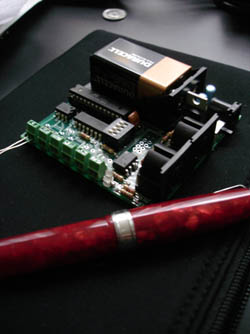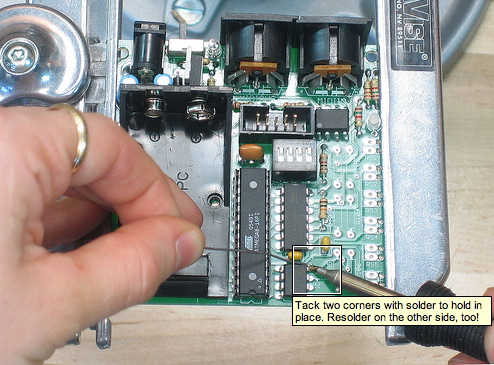
Ready to experiment with sensors for musical (or visual) control, but just want some simple MIDI control so you can use your existing software? An inexpensive, simple, solid option is the MIDIsense board created by Limor Fried (aka Lady Ada), which Limor announced publicly this weekend as a kit. (Some of you already know Limor from her wildly popular x0xb0x Roland TB-303 clone kit, which is also open source.)
I’ve been working with Limor’s board since March, when she tested out the board on a group of us at Eyebeam here in New York. It’s just the thing for building your own flex sensor glove or light sensor Theremin. Here’s a quick look at why it’s cool:
You can build your own board easily: Never touched a soldering iron? Here’s a perfect time to start. The group of mostly-artists at Eyebeam had little-to-no soldering experience, and we had a blast putting these together. None of the solder connections are particularly hard, and the whole project could be up and running in about an hour. It’s a perfect way to cut your teeth on building stuff, and there’s lots of helpful advice at Limor’s site.
MIDI is still really useful: Sure, you could get more resolution out of a board that sends higher-resolution data, but many sensors don’t need that accuracy. The payoff with MIDI is plug-and-play compatibility with an absurd amount of software and hardware. Even if you’re planning on some higher-res projects, it’s worth having a MIDI board around. Trust me on this.
It’s small and cheap: The trend lately has been toward monster sensor input boards that take a zillion kinds of inputs and take up a lot of space. Some of them cost hundreds of dollars. The MIDIsense, by contrast, is super-cheap (US$25 in parts, only slightly more for a ready-to-build kit), and very portable. Each board is specifically tailored to certain kinds of inputs, so you can have a board that works with a certain purpose. Most of my power bricks are bigger.
You don’t have to program anything: The software and hardware are basically ready-to-go once you’ve set up the board. In fact, you don’t even need to touch the computer software if you’re happy with the defaults on the board.
It’s well-documented, and open source: Thought I’d put those in the same line, because you don’t always get both! Limor has done an exceptional job of documenting the process of building a board and using sensors with friendly photos. Newbies will find it makes the whole thing easy to approach, and experts will appreciate the level of detail. Best of all, the thing is open source, so if you are ready to make changes, you can. Or you could make this the starter point for your own board.

Now, MIDIsense isn’t necessarily the perfect board for every process; we’ll be looking at some other boards that are better suited to higher-res data when MIDI isn’t the right choice.
That said, there’s not a single board out there that’s quite this simple and cheap, at least when it comes to MIDI. I can’t think of a better starter board. I’ve got two because an HVAC engineer who came to the workshop gave me his, and I love them both. Now, I just have to get some workshop space and start building stuff with them. Stay tuned here for some MIDIsense-run projects coming soon.
MIDIsense: A real-world MIDI interface platform (hey, what is it with this ongoing real world thing, anyway?)